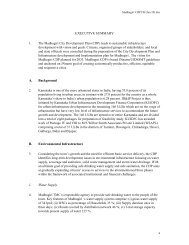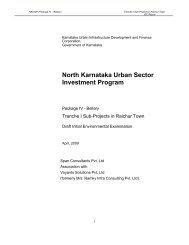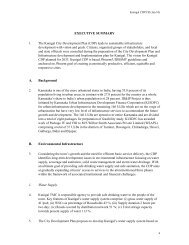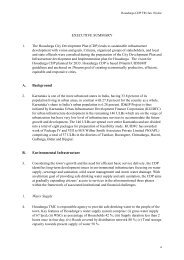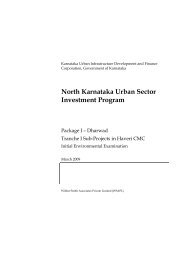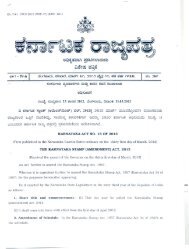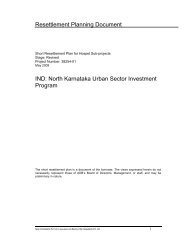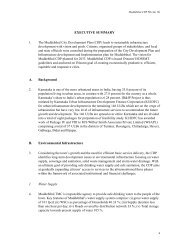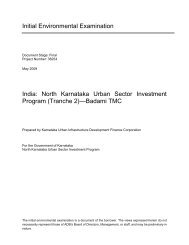KMWEEP-EA Final Report June 3 2008.pdf - kuidfc
KMWEEP-EA Final Report June 3 2008.pdf - kuidfc
KMWEEP-EA Final Report June 3 2008.pdf - kuidfc
You also want an ePaper? Increase the reach of your titles
YUMPU automatically turns print PDFs into web optimized ePapers that Google loves.
KARNATAKA MUNICIPAL WATER PUMPING IMPROVEMENTS IN SIX TOWNSENVIRONMENTAL AUDIT AND PREPARING ENVIRONMENTAL MANAGEMENT PLANFINAL REPORTHindalga Pumping StationMeasures Code Title of Measures Description Status/Date ofImplementationECM 1 Installation of new efficient pumps Replacing 400 HP pump sets by new 600 HP oneswith adequate head resulting in energy savings ondaily basis.ECM 2 Optimization of the existing pumps n/a n/aongoing/May 2008ECM 3Improving the main water flow distributionsystemn/an/aECM 4Reduction in leaks and other unaccounted n/afor watern/aECM 5Water pumping station operationsoptimizationn/an/aECM 6Optimization of existing infrastructurethrough better metering and monitoringmeasuresn/an/aSource: PDD, World BankB-4 Environmental SettingPhysiography and SoilThe city is characterised by Musketry hills to west and Turukmatti hills to the north at an altitudeof about 779 m giving a general slope to the southeast direction. The City is situated on a slopingterrain. Soil in Belgaum is categorised into Red Lateritic, Black Trappean and Sandy soil. Blackcotton soil is also predominant in the region. The geological formation of Belgaum chiefly consistsof the Dharwars, Gneisses, Kaladgi series and the Deccan trap. Soil is categorised by RedLaterite, Black Trappean soil and Sandy soil. The ground water level in Belgaum is relativelyshallow and fluctuates between 5 - 10 m from the ground level.ClimateThe climatic condition in Belgaum is generally salubrious. The lowest and highest temperaturesare recorded in the months of January and April, with 14.3 0 C and 35.4 0 C respectively. The wetmonths are from May to October and dry months are from November to March. The best weatheris experienced in the months of November, December and January. The city receives averagerainfall of 1300 mm and about 68% of the annual rainfall precipitates during the south-westmonsoon season, which lasts from <strong>June</strong> to September. The humidity is over 85% duringmonsoon and about 30% between January and March, the driest part of the year. Thepredominant wind direction in Belgaum is south-east to north-east. The winds blow mainly fromsouth-west and west during the period from April to September. In October, winds blow commonlybetween North and East directions. During November and December, winds are mostly Northeasterlyor easterly, while in January they are south westerly or westerly.Water ResourcesRivers Ghataprabha and Malaprabha cross Belgaum from west to east and form watersheds thatdivide the Ghataprabha basin from the Krishna basin in the south. However, all these surfacewater bodies are outside the city limits of Belgaum. Bellary Nala and Lendi Nala are the twostreams flowing in Belgaum. Kotekere Lake in the Northeast of the city is an important water bodyin the city and has a large command area.31 World Bank



